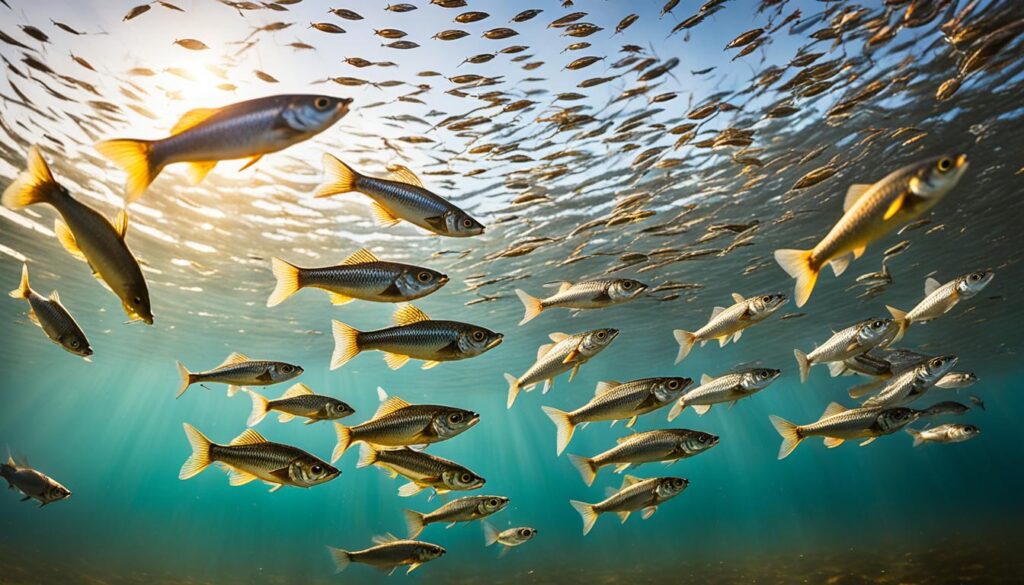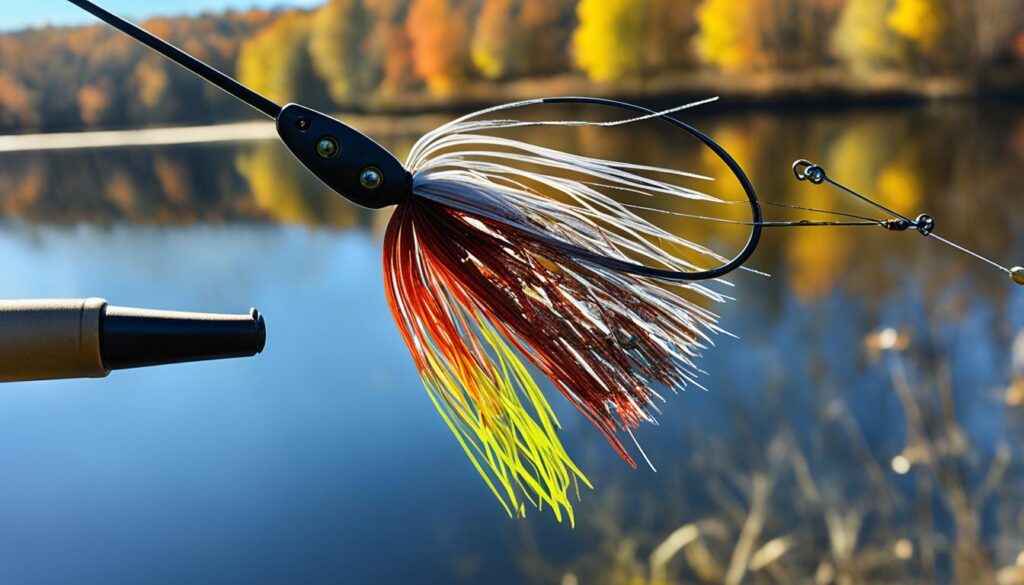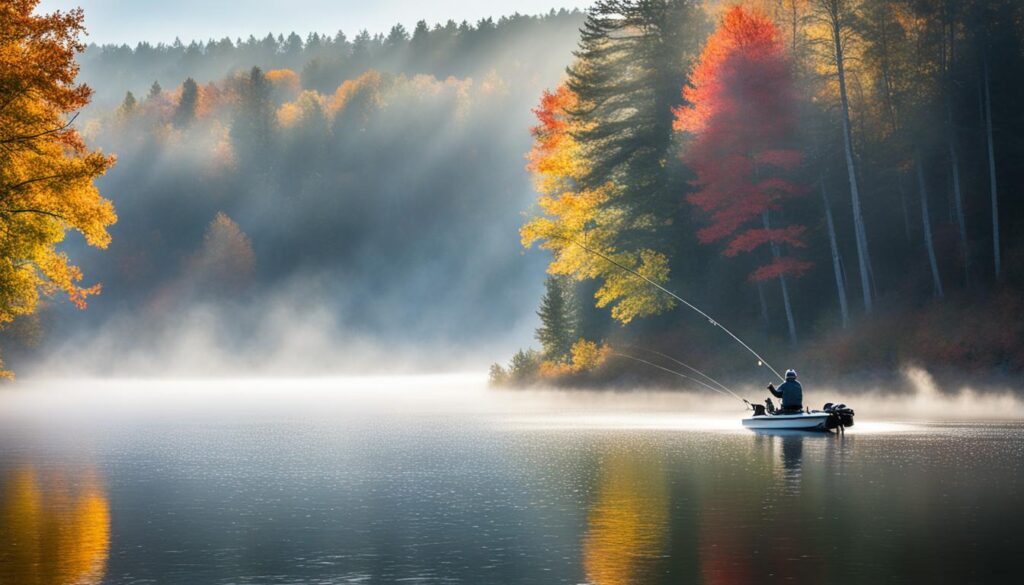As the brisk embrace of late autumn takes hold, bass fishing devotees eagerly anticipate the thrill of hitting the reservoirs. While droves of anglers gravitate towards the sheltered confines of creek channels, I’ve stumbled upon a clandestine strategy that consistently yields remarkable success in the heart of the main lake.
Throughout this article, I’ll divulge the art of targeting bass amidst the expansive central lake waters during late fall, emphasizing the pivotal role of locating baitfish schools and spotlighting the topwater lures essential for hooking trophy-sized catches.
Target Bass in the Main Lake
As late fall sets in, the main lake becomes a prime bass hotspot. Unlike the common belief of migrating to creek backs, the bass often lingers near the main river channel for ample food and shelter. Look for areas with greenery and gentle currents, using electronics to pinpoint submerged structures. Explore the current-exposed edges for baitfish activity, which indicates bass presence. Keep a sharp eye out for surface disturbances or diving birds to locate active feeding zones.
“The main lake can be a game-changer in late fall fishing. It’s a common misconception that the backs of creeks are always the best spots. But if you can find areas with green grass and some current along the main river channel, you’ll have a good chance of finding active bass.” – Randall Tharp, professional angler.
Find the Bait, Find the Bass
In late fall, abundant schools of baitfish, like gizzard and threadfin shad, congregate in the main lake. As temperatures drop, these baitfish form tighter groups, drawing the attention of bass. When scouting for bass, stay mobile and watch for signs of baitfish on your graph or visible in the water. Concentrated baitfish activity indicates potential bass hotspots, making late fall a critical time for baitfish-focused bass hunting in the main lake.

Select the Right Topwater Baits
Late fall bass fishing in reservoirs calls for strategic topwater lure selection. Renowned angler Randall Tharp advises adapting your choice to the prevailing conditions. Tharp favors the aggressive buzzbait to incite strikes for overcast, windy days. Conversely, calm waters call for a subtler approach with a walking bait. Opting for the appropriate topwater bait according to conditions is paramount for success.
Recommended Topwater Baits
| Bait | Recommended Conditions |
|---|---|
| Frog | Heavy cover, overcast conditions |
| Walking Bait | Calmer conditions, clear water |
| Buzzbait | Overcast conditions, windy |
Use Walking Baits in Cover
Bass can’t resist the mesmerizing side-to-side action of a walking bait in the grass. These baits are highly effective in targeting bass hiding in cover during the late fall season. By employing finesse techniques, anglers like myself can skillfully navigate these baits through various types of reservoir cover, surprising themselves with the impressive bass they can attract.
When fishing in reservoirs during late fall, walking baits excel in multiple covers, including submerged vegetation, fallen trees, and dock pilings. The key is to mimic the movement and behavior of injured baitfish, enticing bass to strike out of instinct rather than hunger. With a steady retrieve and slight twitches of the rod tip, you can make the bait dart and dance enticingly, triggering the predatory instincts of late-fall bass.
The image above perfectly captures the excitement of using walking baits in reservoir cover during the late fall season. The key is to explore different reservoir areas, targeting prime cover spots where bass love to hide. You may land that trophy bass you’ve been dreaming of by presenting your walking bait skillfully and strategically.
| Walking Baits in Cover | Benefits |
|---|---|
| 1. Pencil Popper | Perfect for imitating injured baitfish |
| 2. Spook | Great for generating commotion and drawing reactionary strikes |
| 3. Whopper Plopper | Produces a unique, loud thumping sound to grab a bass’s attention |
Buzzbait Setup
Regarding late fall bass fishing, having the proper buzzbait setup is essential for attracting those big bass. I recommend using the Greenfish Tackle Hammerhead Buzz in the White/Nickel color. This buzzbait has a realistic appearance and produces a loud, enticing noise that can grab the attention of bass in colder water temperatures.
To maximize your chances of landing a big bass, I suggest pairing the Greenfish Tackle Hammerhead Buzz with the following equipment: The ARK Brandon Cobb Series Cast Rod provides the perfect combination of sensitivity and durability, allowing you to detect those subtle bites while still having the power to handle larger fish. Paired with Lew’s Super Duty LFS Casting Reel, you’ll have a smooth and reliable setup to handle heavy lifting.
For your line, I recommend using Sufix 131 G-Core Braided Line. This high-quality braided line offers excellent strength and abrasion resistance, giving you the confidence to battle big bass and navigate through the cover without worrying about line breakage.
With the proper buzzbait setup, you’ll be ready to entice bass during the late fall season. Now, get out there and enjoy some exciting topwater action!
| Buzzbait | Rod | Reel | Line |
|---|---|---|---|
| Greenfish Tackle Hammerhead Buzz in White/Nickel | ARK Brandon Cobb Series Cast Rod | Lew’s Super Duty LFS Casting Reel | Sufix 131 G-Core Braided Line |

Walking Bait Setup
To effectively use a walking bait in late fall, it’s essential to have the proper setup. Professional angler Randall Tharp suggests trying out the Team ARK new bait prototype or the Team ARK Topwater Slider in the bone color.
These baits can be paired with an ARK Tharp Series Casting Rod, Shimano Chronarch 150G Casting Reel, Seaguar Smackdown Stealth Gray as the mainline, and Sufix Advance Monofilament as the leader.

| Item | Brand |
|---|---|
| Walking Bait | Team ARK new bait prototype or Team ARK Topwater Slider |
| Casting Rod | ARK Tharp Series |
| Casting Reel | Shimano Chronarch 150G |
| Mainline | Seaguar Smackdown Stealth Gray |
| Leader | Sufix Advance Monofilament |
Late Fall Topwater Lures
Late fall presents an excellent opportunity to employ topwater lures when targeting bass in reservoirs. These lures have the ability to provoke strikes even from the most sluggish fish. Here are four topwater lures that can enhance your success during this season:
Buzzbait
The buzzbait is a topwater lure that creates a disturbance on the water’s surface, attracting bass from beneath. Its rotating blade mimics a wounded baitfish, making it irresistible to hungry bass. This lure shines in overcast conditions with some wind, as its noise and vibration can captivate bass in low-light situations. Opt for a more subtle walking bait in calm waters.
Walking Bait
Also known as a “walk-the-dog” lure, the walking bait replicates a wounded or fleeing baitfish. It produces a side-to-side motion when retrieved, mimicking the movements of struggling prey. Walking baits excel in targeting bass in cover during late fall, particularly in grassy areas. Skillfully navigating this lure through various types of cover can induce strikes from bass hidden among vegetation.
Frog
A frog lure accurately imitates a frog resting on the water’s surface. This lifelike presentation entices bass lurking near shallows, especially around lily pads and dense vegetation. As temperatures drop in late fall, frogs become less active, rendering them vulnerable to predation. With its realistic appearance and action, a frog lure can trigger aggressive strikes from sizable bass seeking an easy meal.
Popper
The popper generates a popping or splashing sound as it moves across the water’s surface. This action replicates a baitfish struggling on the surface, attracting nearby bass. Poppers excel in calm conditions like early mornings or late evenings when the water is still. The popping sound produced by the lure activates the predatory instinct of bass, enticing them to strike.
Combining these topwater lures allows you to cover various depths and water conditions, increasing your chances of landing quality late fall bass. Experiment with retrieve speeds, pauses, and subtle rod movements to present these lures most enticingly. Adapt your lure selection based on prevailing conditions and bass behavior in your target reservoir.
Proper Conditions for Late Fall Topwaters
To determine the ideal conditions for employing topwater lures in late fall, it’s crucial to factor in variables like water temperature and wind. The sweet spot typically lies within a water temperature range of 55-70 degrees Fahrenheit, coupled with light to no wind. These conditions create an optimal setting for topwater action, enhancing the likelihood of enticing bass.
During late fall, bass tend to be more active and responsive near the surface when the water temperature hovers between 55-70 degrees Fahrenheit. Warmer water temperatures within this range stimulate bass aggression, making them more inclined to strike topwater lures. Monitoring water temperature using a reliable thermometer enables anglers to pinpoint the best opportunities for targeting bass with topwater baits.
Wind plays a significant role in late fall topwater fishing. Light to no wind conditions are preferable as they maintain a calm water surface, allowing topwater lures to simulate realistic actions and create enticing ripples that attract bass. Conversely, excessive wind can disrupt the water surface, making it challenging for bass to detect and strike the topwater lure. Thus, planning fishing excursions on days with minimal wind or light breezes is advisable.
Tips for Late Fall Topwater Fishing:
- Monitor water temperature to identify the optimal range for topwater action.
- Check the weather forecast to select days with light or no wind.
- Utilize topwater lures that mimic natural baitfish movements to lure bass.
- Consider fishing during early mornings or late afternoons when bass are most active near the surface.
By observing water temperature and wind conditions, anglers can enhance their success when employing topwater lures in late fall. The convergence of suitable water temperature and minimal wind provides opportunities to elicit aggressive strikes from bass, resulting in exhilarating and fulfilling fishing ventures.
| Water Temperature | Wind Conditions | Topwater Action |
|---|---|---|
| 55-70 degrees | Light to no wind | Optimal |
| Below 55 degrees or above 70 degrees | Excessive wind | Suboptimal |
Discover the Slick Calm Secret Lure
For anglers seeking success in slick, calm conditions with crystal-clear water, the Cotton Cordell Tail Weighted Boy Howdy emerges as a top contender. This innovative stick bait boasts a slender profile complemented by a lead weight, causing it to rest tail-down in the water. Its unique action makes it a prime choice for tranquil water scenarios, particularly in offshore locales featuring brush piles, points, or humps adjacent to creek mouths.
Why Opt for the Cotton Cordell Tail Weighted Boy Howdy?
The Cotton Cordell Tail Weighted Boy Howdy’s versatile features prove its worth in late fall fishing expeditions. Here’s why it stands out as a preferred option for bass fishing in reservoirs:
- Realistic Action: Positioned tail-down, the Boy Howdy expertly imitates a distressed baitfish struggling near the water’s surface, enticing aggressive strikes from hungry bass.
- Slim Profile: Sporting a slender silhouette, this lure mirrors common late fall forage, appearing natural to bass in the ultra-clear waters of reservoirs.
- Easy Casting: Engineered for optimal performance, the Cotton Cordell Tail Weighted Boy Howdy facilitates long, precise casts, empowering anglers to explore expansive water bodies and reach distant fish-holding regions.
- Still Water Effectiveness: In calm water conditions, the subtle yet alluring action of the Boy Howdy captivates bass, particularly in offshore settings where features like brush piles, points, or humps converge near creek mouths.
Embrace the allure of the Slick Calm Secret Lure, and unlock new opportunities for success in late fall bass fishing adventures.
I’ve had tremendous success with the Tail Weighted Boy Howdy in late fall when the water is clear and calm. Its realistic action and ability to target bass in offshore spots have proven to be game-changers. If you’re looking to catch big late fall bass, give the Cotton Cordell Tail Weighted Boy Howdy a try.” – Randall Tharp, Professional Angler
Conclusion
Late fall signals an exhilarating period for topwater bass fishing in reservoirs. The convergence of cooler water temperatures and the abundance of baitfish creates a suitable environment for enticing big bass. To optimize your success rate, it’s crucial to carefully select your topwater baits, focus on the main lake, and pinpoint areas teeming with concentrated baitfish activity.
Walking baits, buzzbaits, frogs, and poppers are highly effective options during late fall. While walking baits shine in covering grassy areas, buzzbaits thrive in overcast conditions with a hint of wind. Frogs are ideal for calm waters, while poppers create enticing disturbances on the water’s surface.
It’s imperative to factor in the proper conditions when employing topwater baits. The optimal late fall topwater action occurs when the water temperature falls within the 55-70 degree range, coupled with light to no wind. Adapting your strategies to match the prevailing conditions and choosing the right lure can significantly enhance your chances of enticing sizable late fall bass.
Gear up and embark on your late fall reservoir expeditions armed with the right topwater baits, a focus on the main lake, and a keen eye for baitfish hotspots. With these tactics, you’re poised for memorable fishing excursions and the thrill of landing trophy bass.
FAQ
What areas should I target when fishing for late fall bass in reservoirs?
It’s important to target the main lake during late fall. Bass and baitfish often stay adjacent to the main river channel, especially if there’s green grass and some current. Look for shallow structure and cover, particularly along the current-exposed edges, to increase your chances of success.
What should I look for when trying to find baitfish during late fall bass fishing in reservoirs?
Vast schools of baitfish, such as gizzard and threadfin shad, typically remain in the main lake during late fall. The colder the water, the tighter the bait groups together. Use your electronics to locate areas with concentrated baitfish activity, as this increases your chances of finding active bass.
What are the recommended topwater baits for late fall bass fishing in reservoirs?
The recommended topwater baits for late fall include buzzbaits, walking baits, frogs, and poppers. Each lure serves a specific purpose and can be effective in different situations during late fall fishing in reservoirs.
How should I fish walking baits in cover during late fall?
Bass can’t resist the side-to-side action of a walking bait in the grass. These baits are highly effective in targeting bass in cover during late fall. By employing finesse techniques and navigating them through various types of cover, you can attract bass even in challenging conditions.
What setup do you recommend for late fall buzzbait fishing?
Professional angler Randall Tharp recommends using the Greenfish Tackle Hammerhead Buzz in the White/Nickel color. Pair it with an ARK Brandon Cobb Series Cast Rod, Lew’s Super Duty LFS Casting Reel, and Sufix 130 G-Core Braided Line for maximum chances of landing a big bass.
What setup do you recommend for late fall walking bait fishing?
Professional angler Randall Tharp suggests trying out the Team ARK new bait prototype or the Team ARK Topwater Slider in the bone color. These baits can be paired with an ARK Tharp Series Casting Rod, Shimano Chronarch 150G Casting Reel, Seaguar Smackdown Stealth Gray as the mainline, and Sufix Advance Monofilament as the leader.
What are some general tips for using topwater lures in late fall reservoir bass fishing?
Late fall offers excellent opportunities for topwater fishing, and there are a few key lures that can increase your chances of success. These include buzzbaits, walking baits, frogs, and poppers. Each lure serves a specific purpose and can be effective in different situations during late fall fishing in reservoirs.
What are the ideal conditions for using topwater lures during late fall bass fishing in reservoirs?
The ideal conditions for using topwater lures during late fall are when the water temperature ranges from 55-70 degrees and there is light to no wind. These conditions create the perfect scenario for topwater action and increase your chances of enticing bass.
Is there a specific lure that works well in slick calm conditions with ultra-clear water during late fall?
In slick calm conditions with ultra-clear water, the Cotton Cordell Tail Weighted Boy Howdy can be highly effective. This unique stick bait features a slender profile with a lead weight on the end, causing it to sit tail-down in the water. Its action is perfect for still water situations, such as offshore spots with brush piles, points, or humps near the mouths of creeks.
What are some key takeaways for late fall topwater bass fishing in reservoirs?
Late fall is an exciting time for topwater bass fishing in reservoirs. Choosing the right topwater baits, targeting the main lake, and finding the baitfish can lead to successful fishing trips. Walking baits, buzzbaits, frogs, and poppers are all effective lures during this season. Remember to consider the proper conditions and adapt your tactics accordingly for the best chances of luring in big late fall bass.
